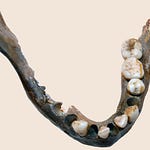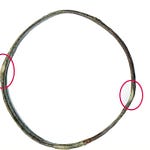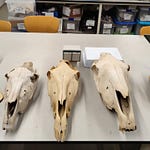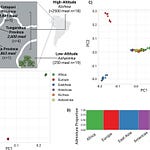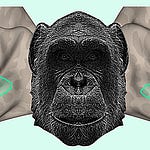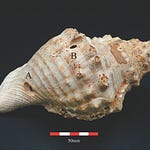For decades, the Neanderthal body has been a byword for strength. Thick bones, broad rib cages, and robust muscle attachments painted a picture of powerful Pleistocene hominins. But a recent study published in Nature Communications1 challenges that image from within, suggesting that some Neanderthals may have had less muscle enzyme activity than modern humans. And some of us may have inherited that trait.

The culprit? A single amino acid substitution in the AMPD1 gene, which helps regulate the chemical conversion of energy within skeletal muscles. Researchers from institutions across Europe and Japan compared high-coverage Neanderthal genomes with those of modern humans, discovering a version of this gene that functioned with markedly reduced efficiency. Evolutionary geneticist Hugo Zeberg,
"The enzyme AMPD1 plays a crucial role in muscle performance. In lab conditions, the Neanderthal variant showed about 25 percent lower activity. In engineered mice, that difference widened to an 80 percent reduction."
A 50,000-Year-Old Genetic Hand-Me-Down
All known Neanderthal genomes carry a specific change: lysine at position 287 in AMPD1 is swapped for isoleucine. While this may seem like a minor tweak, the molecular consequences are anything but. The change disrupts a conserved salt bridge within the protein structure, undermining its stability and diminishing its efficiency.
This variant made its way into modern humans through interbreeding. Today, between two and eight percent of Europeans carry the Neanderthal-derived form of the gene. While not typically linked to disease, it has been found to slightly raise the risk of varicose veins and is significantly underrepresented among elite athletes.
"Carrying a broken AMPD1 enzyme reduces your chances of becoming a top-level athlete by nearly half," said Dominik Macak, the study's first author.
The researchers compiled athletic data from over 2,700 individuals, including elite competitors and control groups. The association between reduced AMPD1 activity and lower athletic performance was consistent across both endurance and power sports.
Not Just Neanderthals: A Modern Mutation Too
Interestingly, another mutation in AMPD1, known as c.C34T, emerged independently in modern humans. It causes a complete loss of function in one copy of the gene and occurs in roughly 9 to 14 percent of Europeans. This variant, too, has been linked to decreased exercise tolerance and higher rates of injury among athletes.
Despite these drawbacks, both the Neanderthal and modern AMPD1 variants remain relatively common. That persistence suggests their effects are generally tolerable in day-to-day life, particularly in societies with reduced physical demands.
"The importance of this enzyme likely diminished as cultural and technological advances reduced the need for extreme muscular performance," Zeberg noted.
When Evolution Loosens the Reins
The fact that a vital muscle gene could become dispensable speaks to broader shifts in hominin life. Whether driven by smaller population sizes in Neanderthals or by new subsistence strategies in Homo sapiens, selection pressures on certain physiological traits may have relaxed.
Comparative analysis shows that among 103 placental mammals, AMPD1 remains highly conserved. Yet in Western Eurasia, it appears natural selection tolerated or even ignored its reduced activity on two separate occasions. In both Neanderthals and modern Europeans, function-weakening mutations found safe harbor in the genome.
And in at least one case, researchers were able to identify a present-day human who had inherited both the Neanderthal and the modern inactive forms. Muscle biopsy showed their AMPD1 activity was roughly 40 percent of normal levels, yet they were otherwise healthy.
Fragility and Adaptation
This study adds texture to the story of human evolution. It shows that robustness is not just about strength but also about tolerance to weakness. Genetic drift, population bottlenecks, and cultural innovations can all conspire to let once-critical genes go soft.
The Neanderthals may still loom large in the public imagination as burly survivors of the Ice Age, but at least at the molecular level, their muscles may have been running on lower octane fuel. And some of us, quite literally, carry that legacy in our legs.
Related Research:
Stepanova, V. et al. (2021). "Reduced purine biosynthesis in humans after their divergence from Neandertals." eLife, 10:e58741. https://doi.org/10.7554/eLife.58741
Lucia, A. et al. (2006). "AMPD1 gene polymorphism and the probability of becoming an elite endurance athlete: a case-control study." Medicine & Science in Sports & Exercise, 38(3), 509–513. https://doi.org/10.1249/01.mss.0000199525.41018.95
Norman, B. et al. (2007). "AMP deaminase 1 deficiency reduces muscle performance but not maximal oxygen consumption in subjects with two nonsense alleles." Journal of Applied Physiology, 102(1), 79–84. https://doi.org/10.1152/japplphysiol.00559.2006
Stepanova, V. & Zeberg, H. (2025). "Evolutionary aspects of AMPD1 deficiency: relaxed selection and functional compensation in modern humans." Trends in Genetics, 41(6), 427–439. https://doi.org/10.1016/j.tig.2025.03.004
Macak, D., Lee, S.-Y., Nyman, T., Ampah-Korsah, H., Strandback, E., Pääbo, S., & Zeberg, H. (2025). Muscle AMP deaminase activity was lower in Neandertals than in modern humans. Nature Communications, 16(1), 6371. https://doi.org/10.1038/s41467-025-61605-4


